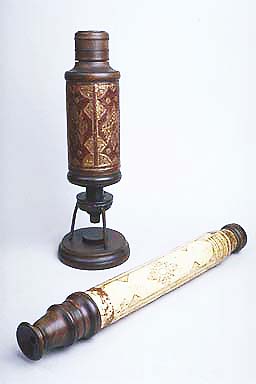A five-drawer refracting telescope, the tubes made of pasteboard, covered with vellum, the lens mounts of lignum vitae. The outer tube is decorated with gold tooling.
In explaining the use of a long zenith telescope with a micrometer eyepiece in an attempted measurement of stellar parallax at Gresham College in 1669, Robert Hooke alluded to the contemporary notion of the decline in sensory power since ancient times and drew a humorous parallel with the failing sight of the old: ‘Hence I judged that whatever mens eyes were in the younger age of the World, our eyes in this old age of it needed Spectacles; and therefore I resolved to assist my eyes with a very large and good Telescope’, (R. Hooke, Lectiones Cutlerianae (London, 1679), p.9).




